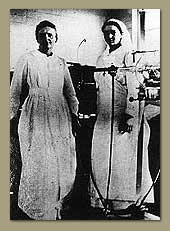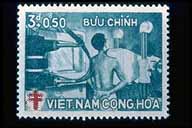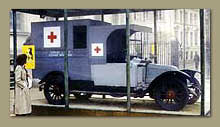http://www.aip.org/history/curie/war1.htm

http://www.aip.org/history/curie/war1.htm
Marie and daughter Irene with x-ray equipment at a military hospital.
Marie created X-ray
vans. But she did not stop there, she went on to provide equipment for
hospitals. The only protection at that time was a metal screen and fabric
gloves. All she needed to do was convince reticent doctors and find well-trained
manipulators. No sooner said than done. Marie trained 150 female manipulators.
World War I
http://www.aip.org/history/curie/war1.htm
X-rays could save soldiers' lives, she realized, by helping doctors see bullets, shrapnel, and broken bones. She convinced the government to empower her to set up France's first military radiology centers. Newly named Director of the Red Cross Radiology Service, she wheedled money and cars out of wealthy acquaintances.
By late October 1914, the first of 20 radiology vehicles she would equip was ready. Because, Marie convinced automobile body shops to transform the cars into vans, and begged manufacturers to do their part for their country by donating equipment.
“The use of the X-rays during the war saved the lives of many wounded men; it also saved many from long suffering and lasting infirmity.”--Marie Curie
* * * * *

"IV-24 1960 Vietnam stamp features the inside of a mobile X-ray van with the patient receiving a photofluorographic chest exam. This stamp carried a surtax for the country's anti-tuberculosis foundation."http://www.xray.hmc.psu.edu/rci/ss4/ss4_7.html
